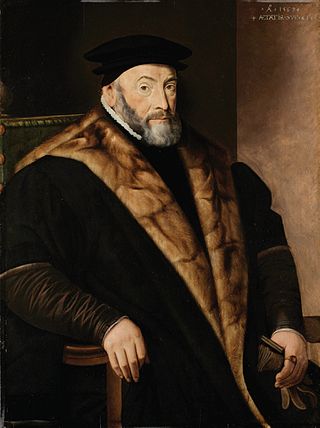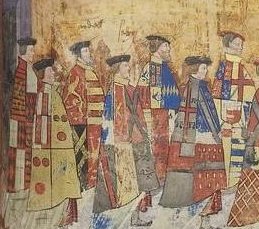
Reginald Pole was an English cardinal and the last Catholic archbishop of Canterbury, holding the office from 1556 to 1558, during the Counter-Reformation.

Margaret Plantagenet, Countess of Salisbury, was the only surviving daughter of George Plantagenet, Duke of Clarence, a brother of Kings Edward IV and Richard III, by his wife Isabel Neville. As a result of her marriage to Richard Pole, she was also known as Margaret Pole. One of the few members of the House of Plantagenet to have survived the Wars of the Roses, she was executed in 1541 at the command of King Henry VIII, the second monarch of the House of Tudor, who was the son of her first cousin, Elizabeth of York. Pope Leo XIII beatified her as a martyr for the Catholic Church on 29 December 1886. One of her sons, Reginald Pole was the last Catholic Archbishop of Canterbury.

Thomas Audley, 1st Baron Audley of Walden KG, PC, KS, JP, was an English barrister and judge who served as Lord Chancellor of England from 1533 to 1544.

Earl of Devon is a title that has been created several times in the Peerage of England. It was possessed first by the Redvers family, and later by the Courtenay family. It is not to be confused with the title of Earl of Devonshire, which is held by the Duke of Devonshire, although the letters patent for the creation of the latter peerages used the same Latin words, Comes Devon(iae). It was a re-invention, if not an actual continuation, of the pre-Conquest office of Ealdorman of Devon.

Earl of Salisbury is a title that has been created several times in English and British history. It has a complex history, and is now a subsidiary title to the marquessate of Salisbury.
In English criminal law, attainder was the metaphorical "stain" or "corruption of blood" which arose from being condemned for a serious capital crime. It entailed losing not only one's life, property and hereditary titles, but typically also the right to pass them on to one's heirs. Both men and women condemned of capital crimes could be attainted.
Henry Pole, 1st Baron Montagu, was an English nobleman, the only holder of the title Baron Montagu under its 1514 creation, and one of the relatives whom King Henry VIII of England had executed for treason.

William FitzWilliam, 1st Earl of Southampton, KG, English courtier and soldier, was the third son of Sir Thomas FitzWilliam of Aldwark and Lady Lucy Neville, daughter of John Neville, 1st Marquess of Montagu.

Henry Courtenay, 1st Marquess of Exeter, 2nd Earl of Devon, KG, PC, feudal baron of Okehampton, feudal baron of Plympton, of Tiverton Castle, Okehampton Castle and Colcombe Castle all in Devon, was a grandson of King Edward IV, nephew of the queen consort, Elizabeth of York and a first cousin of King Henry VIII. Henry Courtenay was a close friend of Henry VIII, having "been brought up of a child with his grace in his chamber".

Edward Courtenay, 1st Earl of Devon was an English nobleman during the rule of the Tudor dynasty. Born into a family with close royal connections, he was at various times considered a possible match for the two daughters of Henry VIII, both of whom became queens regnant of England. He was a second cousin to Edward VI, Mary I and Elizabeth I through King Edward IV.

Sir Nicholas Carew KG, of Beddington in Surrey, was an English courtier and diplomat during the reign of King Henry VIII. He was executed for his alleged part in the Exeter Conspiracy.

William Courtenay, 1st Earl of Devon, feudal baron of Okehampton and feudal baron of Plympton, was a member of the leading noble family of Devon. His principal seat was Tiverton Castle, Devon with further residences at Okehampton Castle and Colcombe Castle, also in that county.
Sir Edward Neville was an English courtier. He was born at Abergavenny, Monmouthshire. He was the son of George Neville, 4th Baron Bergavenny and his wife Margaret, daughter of Hugh Fenn. He married Eleanor Windsor, daughter of Andrew Windsor, 1st Baron Windsor and Elizabeth Blount, before 6 April 1529. He was the brother of George Nevill, 5th Baron Bergavenny and the two of them became close to King Henry VIII and the Queen, Catherine of Aragon.
Ursula Pole, Baroness Stafford was an English noblewoman; the wife of Henry Stafford, 1st Baron Stafford; a wealthy heiress and the only daughter of Margaret Pole, 8th Countess of Salisbury. Her mother was the last surviving member of the Plantagenet dynasty and was executed for treason at the age of 67 in 1541 by the command of King Henry VIII.

Edward Courtenay, 1st Earl of Devon, KG was an English nobleman. He was a member of the ancient Courtenay family.

Sir Richard Pole, KG was a supporter and first cousin of King Henry VII of England. He was created a Knight of the Garter and was married to Margaret Plantagenet, a member of the House of York. The marriage reinforced the Tudor alliance between the houses of York and Lancaster.
Sir Geoffrey Pole of Lordington, Sussex was an English knight who supported the Catholic Church in England and Wales when Henry VIII of England was establishing the alternative Church of England with himself as leader.
Buckingham's rebellion was a failed but significant uprising, or collection of uprisings, of October 1483 in England and parts of Wales against Richard III of England.
Katherine Stourton, Baroness Grey of Codnor was an English noblewoman. Her life reflects the turbulence of English political life in the late fifteenth and early sixteenth centuries; her first husband was attainted for treason, and her third husband holds the record for the longest period of imprisonment in the Tower of London.

The King's Curse is a 2014 historical novel by Philippa Gregory, part of her series The Cousins' War. A direct sequel to The White Princess, it follows the adult life of Margaret Pole, Countess of Salisbury, the daughter of George Plantagenet, 1st Duke of Clarence and Isabel Neville.











